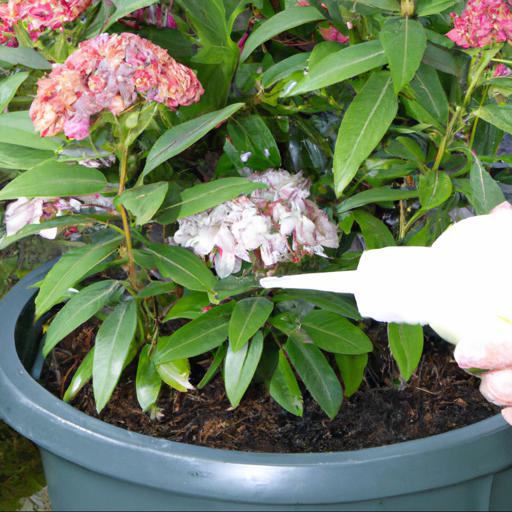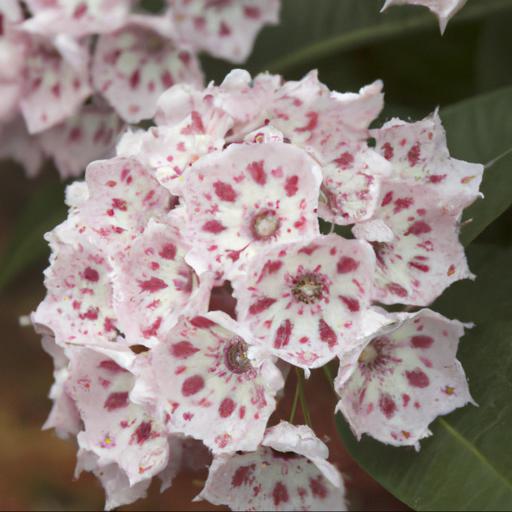Kalmia latifolia, commonly known as mountain laurel, is a beautiful flowering shrub native to the eastern United States. It is an evergreen shrub with glossy, dark green leaves and clusters of fragrant white or pink flowers that bloom in early summer. Mountain laurel is a popular ornamental plant, and its wood is often used for furniture and other woodworking projects.
In this blog, we will explore the many benefits of growing Kalmia latifolia, from its attractive appearance to its medicinal properties. We will also discuss the best ways to care for and propagate this lovely shrub.
Benefits of kalmia latifolia

Kalmia Latifolia is an evergreen shrub renowned for its beauty and hardiness, making it an ideal choice for gardens in the United Kingdom. Not only is Kalmia Latifolia aesthetically pleasing with its deep green foliage that is highlighted with shades of red and magenta, but it can also thrive in many different climates and offers numerous benefits to your landscape. The most notable advantage of Kalmia Latifolia is its hardiness.
It can thrive in both Sun and part-shade, while the plant itself is resilient enough to survive both hot and cold spells. This makes it an ideal plant for the UK climate, making it able to cope when temperatures dip down to lower levels.
Further, its ability to withstand high winds and a generally wet climate provide it with an extra edge when it comes to being a garden staple. Kalmia Latifolia is also known for its impactful aesthetics, with robust red branches lined with deep green leaves that completely transform whatever landscape it graces.
The magenta colour on the leaf edges provides a stunning contrast to the dark green hue, a colour hailing from the classic foliage found in forests and mountains. Furthermore, the foliage of this evergreen is known to be long-lasting, ensuring you get the most out of your investment. In addition to its aesthetic advantage, Kalmia Latifolia is impressively easy to care for.
Low maintenance and only needing to be trimmed every few years, this plant can be a low-cost addition to the garden that requires minimal effort. As an added benefit, the shrub is very resistant to pests and diseases, helping it to stay strong and healthy throughout the year. Overall, Kalmia Latifolia is a tried and tested evergreen shrub that can offer enormous benefits to any UK gardening project.
With its unique combination of hardiness, beauty and low maintenance, Kalmia Latifolia is the perfect addition to your landscape.
Growing kalmia latifolia

Are you looking for a bold and eye-catching evergreen shrub for your garden that’s low maintenance and adds year-round interest? Then Kalmia latifolia, or the mountain laurel, is the perfect bush for you! This shrub is native to the woodlands of the eastern United States and has been popular with gardeners for many years, creating a gorgeous show of flowers in the late spring and early summer.
The evergreen foliage is a striking dark green and is accompanied by clusters of fragrant cup-shaped flowers, which turn to beautiful red berries in late summer and fall. The mountain laurel is also an excellent choice for hedges and foundation plants as it’s evergreen, highly tolerant of salt and is pest-resistant.
Plant them in full sun or partial shade and be sure to keep the young shrubs well-watered for establishing their root system. Kalmia latifolia can reach heights up to five meters and should be pruned to the desired size annually or bi-annually.
Mountain laurel is ideal for lining walkways, borders, and hedges and it provides interest throughout all four seasons, making it a great, low maintenance addition to any UK garden. Add this stunning shrub to your garden and create a burst of colour and a gentle, sweet fragrance every year!
Caring for kalmia latifolia

Kalmia latifolia, or mountain laurel, is a stunning evergreen shrub that is native to North America. Although commonly found in the wild, mountain laurel can also be grown in the UK garden if the right care is given.
With its lush foliage, bright blooms and long lasting appeal, it will add a touch of elegance to any outdoor space. To ensure optimal health and growth of your mountain laurel, it should be planted in a sunny spot that is sheltered from strong winds. The soil should be on the fertile side with good drainage and should be supplemented with a layer of mulch each spring.
Watering should be done regularly throughout the growing season, making sure not to let the soil completely dry out. It is also a good idea to feed your mountain laurel with a slow release fertilizer in early spring and mid-summer. Once your mountain laurel begins to flower, you should ensure that it is adequately deadheaded.
Deadheading helps encourage more blooms and prolongs the flowering period. Any faded flowers should be removed with a pair of garden scissors or a bypass pruner.
Additionally, once growth has slowed down in the fall, it is best to prune the shrub back to maintain its shape and allow the sunlight to penetrate the inner foliage. Overall, with some simple maintenance, your mountain laurel can flourish and bring a year-round burst of beauty and texture to your UK garden.
Interesting facts about kalmia latifolia
. Kalmia Latifolia, also known as Mountain Laurel, is a spectacular evergreen shrub native to the Eastern USA and is known for its prized showy flowers that come in shades of pink, white and purple.
A beautiful, multi-seasonal flowering shrub, Kalmia latifolia is a must-have for any UK garden looking to add a splash of rich colour. This hardy perennial shrub is the state flower of Connecticut, and the common name Mountain Laurel reflects its habitat – preferring conditions such as acidic soil, sandy loam and moist areas. When in bloom it makes a dramatic appearance, its full leaves covered in clusters of up to 20 flower petals giving rise to a miniature explosion of color.
Plant in a sunny location for an eye-catching display year round. Aside from looking good, Kalmia latifolia also produces an impressive health benefit – it is lush with antioxidants and anti-inflammatory compounds which makes it beneficial for treating ailments such as skin rashes and joint pain. Plus, its nectar-rich flowers make it a food source for birds and butterflies.
So make sure to consider adding this unique evergreen shrub to your garden. While delicate in appearance, Kalmia latifolia is a hardy plant that will bring beauty and benefits for years to come.
Our video recommendation
Conclusion
Kalmia latifolia, commonly known as mountain laurel, is an evergreen shrub native to the Appalachian Mountains. It has glossy, dark green leaves and clusters of pink or white flowers that bloom in late spring and early summer.
This hardy plant is a great choice for hedges and borders, and it can also be used as a specimen plant in the garden. It is tolerant of most soil types and can thrive in both sun and shade. With its attractive foliage and fragrant blooms, Kalmia latifolia is a beautiful addition to any landscape.
FAQ
What is the scientific name of Kalmia latifolia?
The scientific name of Kalmia latifolia is Rhododendron latifolium.
What are the common names of Kalmia latifolia?
The common names of Kalmia latifolia are mountain laurel, calico bush, and spoonwood.
What are the characteristics of Kalmia latifolia?
Kalmia latifolia is an evergreen shrub with glossy, dark green leaves and clusters of pink, bell-shaped flowers. It is native to the eastern United States and can grow up to 10 feet tall. It prefers moist, acidic soil and full sun to partial shade. It is also tolerant of drought and salt.
Where is Kalmia latifolia native to?
Kalmia latifolia is native to eastern North America, ranging from Nova Scotia south to Florida and west to Minnesota.
How is Kalmia latifolia used in landscaping?
Kalmia latifolia is commonly used in landscaping as an ornamental shrub due to its attractive evergreen foliage and showy flowers. It is also used as a hedge or border plant, and can be pruned to create a more formal look.
What are the potential health benefits of Kalmia latifolia?
The potential health benefits of Kalmia latifolia include reducing inflammation, improving digestion, relieving pain, and boosting the immune system. It may also help to reduce fever, treat respiratory infections, and reduce the risk of certain cancers.

